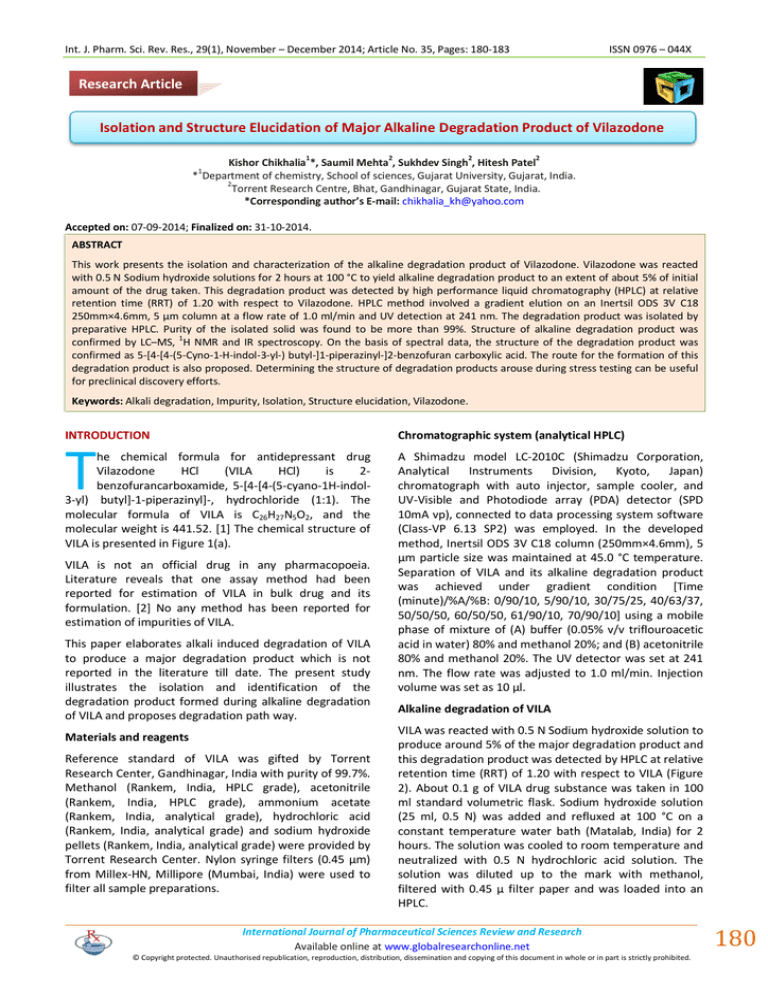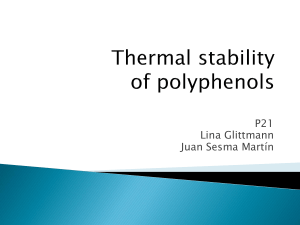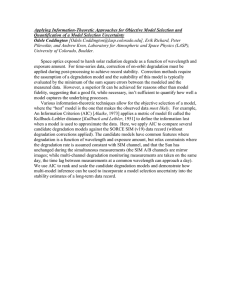Document 13310096
advertisement

Int. J. Pharm. Sci. Rev. Res., 29(1), November – December 2014; Article No. 35, Pages: 180-183 ISSN 0976 – 044X Research Article Isolation and Structure Elucidation of Major Alkaline Degradation Product of Vilazodone 1 2 2 2 Kishor Chikhalia *, Saumil Mehta , Sukhdev Singh , Hitesh Patel 1 * Department of chemistry, School of sciences, Gujarat University, Gujarat, India. 2 Torrent Research Centre, Bhat, Gandhinagar, Gujarat State, India. *Corresponding author’s E-mail: chikhalia_kh@yahoo.com Accepted on: 07-09-2014; Finalized on: 31-10-2014. ABSTRACT This work presents the isolation and characterization of the alkaline degradation product of Vilazodone. Vilazodone was reacted with 0.5 N Sodium hydroxide solutions for 2 hours at 100 °C to yield alkaline degradation product to an extent of about 5% of initial amount of the drug taken. This degradation product was detected by high performance liquid chromatography (HPLC) at relative retention time (RRT) of 1.20 with respect to Vilazodone. HPLC method involved a gradient elution on an Inertsil ODS 3V C18 250mm×4.6mm, 5 µm column at a flow rate of 1.0 ml/min and UV detection at 241 nm. The degradation product was isolated by preparative HPLC. Purity of the isolated solid was found to be more than 99%. Structure of alkaline degradation product was 1 confirmed by LC–MS, H NMR and IR spectroscopy. On the basis of spectral data, the structure of the degradation product was confirmed as 5-[4-[4-(5-Cyno-1-H-indol-3-yl-) butyl-]1-piperazinyl-]2-benzofuran carboxylic acid. The route for the formation of this degradation product is also proposed. Determining the structure of degradation products arouse during stress testing can be useful for preclinical discovery efforts. Keywords: Alkali degradation, Impurity, Isolation, Structure elucidation, Vilazodone. INTRODUCTION Chromatographic system (analytical HPLC) T he chemical formula for antidepressant drug Vilazodone HCl (VILA HCl) is 2benzofurancarboxamide, 5-[4-[4-(5-cyano-1H-indol3-yl) butyl]-1-piperazinyl]-, hydrochloride (1:1). The molecular formula of VILA is C26H27N5O2, and the molecular weight is 441.52. [1] The chemical structure of VILA is presented in Figure 1(a). VILA is not an official drug in any pharmacopoeia. Literature reveals that one assay method had been reported for estimation of VILA in bulk drug and its formulation. [2] No any method has been reported for estimation of impurities of VILA. This paper elaborates alkali induced degradation of VILA to produce a major degradation product which is not reported in the literature till date. The present study illustrates the isolation and identification of the degradation product formed during alkaline degradation of VILA and proposes degradation path way. Materials and reagents Reference standard of VILA was gifted by Torrent Research Center, Gandhinagar, India with purity of 99.7%. Methanol (Rankem, India, HPLC grade), acetonitrile (Rankem, India, HPLC grade), ammonium acetate (Rankem, India, analytical grade), hydrochloric acid (Rankem, India, analytical grade) and sodium hydroxide pellets (Rankem, India, analytical grade) were provided by Torrent Research Center. Nylon syringe filters (0.45 µm) from Millex-HN, Millipore (Mumbai, India) were used to filter all sample preparations. A Shimadzu model LC-2010C (Shimadzu Corporation, Analytical Instruments Division, Kyoto, Japan) chromatograph with auto injector, sample cooler, and UV-Visible and Photodiode array (PDA) detector (SPD 10mA vp), connected to data processing system software (Class-VP 6.13 SP2) was employed. In the developed method, Inertsil ODS 3V C18 column (250mm×4.6mm), 5 µm particle size was maintained at 45.0 °C temperature. Separation of VILA and its alkaline degradation product was achieved under gradient condition [Time (minute)/%A/%B: 0/90/10, 5/90/10, 30/75/25, 40/63/37, 50/50/50, 60/50/50, 61/90/10, 70/90/10] using a mobile phase of mixture of (A) buffer (0.05% v/v triflouroacetic acid in water) 80% and methanol 20%; and (B) acetonitrile 80% and methanol 20%. The UV detector was set at 241 nm. The flow rate was adjusted to 1.0 ml/min. Injection volume was set as 10 µl. Alkaline degradation of VILA VILA was reacted with 0.5 N Sodium hydroxide solution to produce around 5% of the major degradation product and this degradation product was detected by HPLC at relative retention time (RRT) of 1.20 with respect to VILA (Figure 2). About 0.1 g of VILA drug substance was taken in 100 ml standard volumetric flask. Sodium hydroxide solution (25 ml, 0.5 N) was added and refluxed at 100 °C on a constant temperature water bath (Matalab, India) for 2 hours. The solution was cooled to room temperature and neutralized with 0.5 N hydrochloric acid solution. The solution was diluted up to the mark with methanol, filtered with 0.45 µ filter paper and was loaded into an HPLC. International Journal of Pharmaceutical Sciences Review and Research Available online at www.globalresearchonline.net © Copyright protected. Unauthorised republication, reproduction, distribution, dissemination and copying of this document in whole or in part is strictly prohibited. 180 © Copyright pro Int. J. Pharm. Sci. Rev. Res., 29(1), November – December 2014; Article No. 35, Pages: 180-183 ISSN 0976 – 044X bromide (KBr) dispersion using Bruker (TENSOR 27) IR spectrophotometer (Ettlingen, Germany). NMR spectroscopy 1 The H NMR experiments were performed on AVANCE DPX 400 Bruker NMR spectrophotometer (Fallanden, Switzerland). DMSO-d6 was used as a diluent and tetramethylsilane was used as internal standard. Mass spectrometry Preparative HPLC Waters preparative HPLC (Delta Prep) 4000 system (Waters Corporation, Milford, MA, USA) with high pressure unit of 4000 psi equipped with fraction collector was used. It was operated through Empower software. Separation of VILA and its alkaline degradation product was achieved by gradient elution [Time (minute)/%A/%B: 0/65/35, 5/65/35, 15/55/45, 20/55/45, 22/65/35, 30/65/35] of ammonium acetate buffer (0.1% w/v ammonium acetate in water) and acetonitrile. X-bridge (Waters) C18 (150mm×30mm) preparative column packed with 5 µm particle sizes was employed for separation and isolation of the degradation product at ambient temperature. Flow rate was kept at 40 ml/min. The detection was monitored at a wavelength of 241 nm. Isolation of degradation product by preparative HPLC The alkaline degradation solution of VILA loaded on preparative HPLC using conditions mentioned in sub section “preparative HPLC” and these isolated fractions were collected at appropriate time. The collected fractions were mixed and the solution was concentrated on a Buchi rotavapor R-124 (Buchi Labortechnik, Switzerland) and analyzed by analytical HPLC using conditions mentioned in sub section “chromatographic system (analytical HPLC)”. The isolated fractions having purity greater than 99.0% were pooled together and methanol was then evaporated using rotavapor with B490 water bath to get solid impurity. The solid obtained was then dried. IR spectroscopy The IR spectra of VILA and its alkaline degradation product were recorded in solid state as Potassium The mass spectra of VILA and its alkaline Degradation product were recorded on LXQ ion trap mass spectrometer (ThermoFinnigan, United Kingdom) equipped with a turboionspray interface at 300°C. Detection of ions was performed in Electrospray ionization positive ion mode. Data acquisition and processing were done using Xcalibur 2.0SR2 software. RESULTS AND DISCUSSION Isolation of major alkaline degradation of VILA VILA was subjected to alkaline degradation as discussed in sub section “alkaline degradation of VILA” of section “EXPERIMENTAL” to generate about 5% of major degradation. This degraded solution was subjected to preparative chromatography to enable the isolation of the degradation. The purity of this solid was assessed to be more than 99%. The degradation was then characterized by IR, 1H NMR and LC-MS techniques. Structure elucidation of alkaline degradation product of VILA In the IR spectrum of API, the absorption frequency for ketone group (-C=O) was observed at 1669 cm−1, which was shifting at 1601 cm−1 due to conversa on of amino group (–NH2) to hydroxyl group (–OH). In degradation product, a broad spectrum was observed at 3390 cm−1. Significant peak assignment of IR spectra of both the VILA and the degradation product are shown in Table 1. 1 From HNMR spectra, 25 hydrogens were observed in alkaline degradation impurity while 28 hydrogens were observed in VILA. One major change observed was the signal at 7.70 ppm and 8.17 ppm indicated two protons for –NH2 group, which was not observed in degradation product. So here losses of three hydrogens are two 1 hydrogens of –NH2 group and one hydrogen of HCl. H International Journal of Pharmaceutical Sciences Review and Research Available online at www.globalresearchonline.net © Copyright protected. Unauthorised republication, reproduction, distribution, dissemination and copying of this document in whole or in part is strictly prohibited. 181 © Copyright pro Int. J. Pharm. Sci. Rev. Res., 29(1), November – December 2014; Article No. 35, Pages: 180-183 NMR spectral assignments of both VILA and its major alkaline degradation product are presented in Table 2. Table 1: Spectral details of FT-IR spectra of VILA and its degradation product ISSN 0976 – 044X and a third ion m/z of 247 amu corresponding to breakage of moiety. The fragmentation pattern of major alkaline degradation product is shown in Figure 3. Peak observed in (cm-1) Peak assignment VILA Degradation product -NH stretching 3437 3491 Aromatic C-H stretching 3005 3023 Aliphatic C-H stretching 2939 2944 C≡N stretching 2220 2217 C=O stretching 1669 1601 C=C ring stretching 1575&1443 1563&1447 1368,1247&1226 1360,1320,1217 and 1125 C-N stretching overlapping with C-O-C stretching -OH stretching --- Broad spectrum at 3390 VILA Degradant From, IR data, Mass data and from NMR data it can be concluded that these can be possible only when the –NH2 group in VILA is replaced by –OH group in alkaline degradation. Hence, the structure of the degradation product is elucidated as 5-[4-[4-(5-Cyno-1-H-indol-3-yl-) butyl-]1-piperazinyl-]2-benzofuran carboxylic acid (Figure 1(b)). H-25 1, 11.20 (b,s) 1, 11.38 (s) Proposed alkaline degradation pathway H-28 1, 8.13 (b,s) 1, 8.08 (b,s) H-6,31 2, 7.54-7.57 (m) 2, 7.49-7.53 (d) H-3 1, 7.53 (s) 1, 7.43 (s) H-24,30 2, 7.43-7.45 (d) 2, 7.34-7.41 (d) The degradation pathway of VILA in alkaline conditions is proposed by the pathway, shown in Figure 4. The amide group is cleaved upon alkaline hydrolysis and leads to the formation of degradation product, with the loss of a –NH2 group and gain of a –OH group. H-7 1, 7.21-7.23 (d) 1, 7.19-7.22 (d) H-9 1, 7.27 (d) 1, 7.15-7.16 (d) H-13,17 4, 3.56, 3.73 (d) 4, 3.15 (t) H-22 2, 2.77-2.80 (t) 2, 2.73-2.77 (t) Table 2: 1H NMR spectral assignments of VILA and its degradation product Assignments H-14,16 H-19 Number of protons, Chemical shift (ppm), multiplicity 6, 3.19-3.26 (m) 4, 2.64 (t) 2, 2.49 (t) H-20,21 4, 1.69-1.85 (m) 4, 1.56-1.70 (m) H-18 2, 7.70, 8.17 (b,s) *----- H-34 1, 11.64 (s) ----- B: broad; s: singlet; d: doublet; t: triplet; m: multiplet The electro spray ionization (ESI) mass spectrum of VILA exhibited a molecular ion peak at m/z of 442.42 [M+H]+ supporting a molecular weight of 441. The mass spectrum of the degradation product exhibited a molecular ion peak at m/z of 443.25 [M+H]+ supporting a molecular weight of 442. The mass spectrum of the fragmentation of degradation product shows a major ion at m/z of 397 atomic mass unit (amu) corresponding to loss of Carboxylic acid group, a second major ion m/z of 197 amu CONCLUSION Determining the structure of degradation product in the stress testing can be useful in drug substance development and drug product development. From the structure of the degradation product toxicity of the drug can be predicted. VILA undergoes degradation in alkaline conditions, which was detected by HPLC and isolation of International Journal of Pharmaceutical Sciences Review and Research Available online at www.globalresearchonline.net © Copyright protected. Unauthorised republication, reproduction, distribution, dissemination and copying of this document in whole or in part is strictly prohibited. 182 © Copyright pro Int. J. Pharm. Sci. Rev. Res., 29(1), November – December 2014; Article No. 35, Pages: 180-183 alkaline degradants was achieved using preparative chromatography. The structure of this degradants was characterized by IR, 1H NMR and mass spectroscopic studies and elucidated as 5-[4-[4-(5-Cyno-1-H-indol-3-yl-) butyl-]1-piperazinyl-]2-benzofuran carboxylic acid. ISSN 0976 – 044X REFERENCES 1. M.P. Cruz MP, Vilazodone HCl (Viibryd) - A Serotonin Partial Agonist and Reuptake Inhibitor for the Treatment of major depressive disorder, Pharmacy & Therapeutics, 37, 2012, 28–31. 2. Reddy PB, International Journal of Biological and Pharmaceutical Research, 3, 2012, 789-795. Source of Support: Nil, Conflict of Interest: None. International Journal of Pharmaceutical Sciences Review and Research Available online at www.globalresearchonline.net © Copyright protected. Unauthorised republication, reproduction, distribution, dissemination and copying of this document in whole or in part is strictly prohibited. 183 © Copyright pro

![Pre-workshop questionnaire for CEDRA Workshop [ ], [ ]](http://s2.studylib.net/store/data/010861335_1-6acdefcd9c672b666e2e207b48b7be0a-300x300.png)




